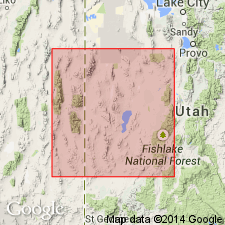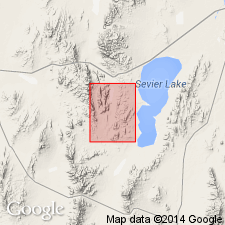
- Usage in publication:
-
- Whirlwind formation
- Modifications:
-
- Named
- Dominant lithology:
-
- Limestone
- AAPG geologic province:
-
- Great Basin province
Summary:
Named for Whirlwind Valley east of House Range, Millard Co, UT in Great Basin province. Type section designated along Marjum in the House Range. Name Whirlwind applied to the basal 117 ft of the type Swasey limestone and Swasey restricted to cliff-forming upper part of Swasey of earlier reports. [Author could have assigned member rank to Whirlwind, placed it in Swasey without revising basal contact of Swasey.] Lithologic description of type Whirlwind not included in this report. Reader is referred to the section measured on a spur between tributary valleys on north side of Marjum Canyon in the House Range by Deiss (1938, Geological Society of America Bulletin, v. 49, no. 7, p. 1067-1168) in which the Whirlwind described as consisting of gray, thin-bedded, arenaceous, platy limestone and tan clay shale, some intraformational conglomerate, and has trilobite fossils. Correlation chart, cross section. Special recognition of Whirlwind given because of its distinctive lithology and its position in the BATHYURISCUS-ELRATHINA trilobite assemblage zone. Overlies Dome [limestone] in House and Wah Wah Ranges, and Pioche district, Lincoln Co, NV. Underlies Swasey in west UT and Highland Peak [limestone] in Pioche district. Middle Cambrian age.
Source: GNU records (USGS DDS-6; Denver GNULEX).

- Usage in publication:
-
- Whirlwind Formation*
- Modifications:
-
- Adopted
- AAPG geologic province:
-
- Great Basin province
Summary:
Whirlwind Formation of Robison (1960) is adopted. Consists of slope-forming olive shale with thin limestone interbeds that contain trilobites. Is 40 ft thick. Conformably overlies Dome Limestone; conformably underlies Swasey Limestone. Age is Cambrian.
Source: GNU records (USGS DDS-6; Menlo GNULEX).

- Usage in publication:
-
- Whirlwind Formation
- Modifications:
-
- Overview
- AAPG geologic province:
-
- Great Basin province
Summary:
Whirlwind Formation originally considered lower part of the Swasey Limestone. Wheeler (1948) first suggested that shaly lower part of the Swasey be renamed the Condor [member] with the type section in the Pioche area of NV. Robison (1960) considered the "Condor" to be inappropriate and proposed the name Whirlwind, at the same time restricting the Swasey. Upper part is characterized by EHMANELLA [trilobite] coquinas. Contains 1 to 93 percent insoluble residue; average 26 percent. Age is Middle Cambrian on the basis of fossils [trilobites].
Source: GNU records (USGS DDS-6; Menlo GNULEX).
For more information, please contact Nancy Stamm, Geologic Names Committee Secretary.
Asterisk (*) indicates published by U.S. Geological Survey authors.
"No current usage" (†) implies that a name has been abandoned or has fallen into disuse. Former usage and, if known, replacement name given in parentheses ( ).
Slash (/) indicates name conflicts with nomenclatural guidelines (CSN, 1933; ACSN, 1961, 1970; NACSN, 1983, 2005, 2021). May be explained within brackets ([ ]).

